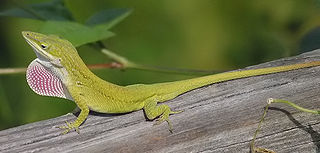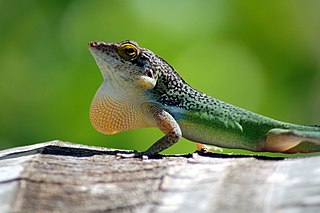There are two species of lizard named copper anole:
- Anolis cupreus , found in Honduras, Nicaragua, and Costa Rica
- Anolis cuprinus , found in Mexico
There are two species of lizard named copper anole:

Dactyloidae are a family of lizards commonly known as anoles and native to warmer parts of the Americas, ranging from southeastern United States to Paraguay. Instead of treating it as a family, some authorities prefer to treat it as a subfamily, Dactyloidae, of the family Iguanidae. In the past they were included in the family Polychrotidae together with Polychrus, but the latter genus is not closely related to the true anoles.

Anolis is a genus of anoles, iguanian lizards in the family Dactyloidae, native to the Americas. With more than 425 species, it represents the world's most species-rich amniote tetrapod genus, although it has been proposed that many of these should be moved to other genera, in which case only about 45 Anolis species remain. Previously, it was classified under the family Polychrotidae that contained all the anoles as well as Polychrus, but recent studies place it under Dactyloidae.

The brown anole, also known commonly as the Bahaman anole or De la Sagra's anole, is a species of lizard in the family Dactyloidae. The species is native to Cuba and the Bahamas. It has been widely introduced elsewhere, via the importation and exportation of plants where the anole would lay eggs in the soil of the pots, and is now found in Florida and as far north in the United States as southern Georgia, Texas, Louisiana, Mississippi, Alabama, Hawaii, and Southern California. It has also been introduced to other Caribbean islands and Taiwan in Asia.
Cuban anole may refer to:
A. occultus may refer to:

Anolis cristatellus is a small species of anole, belonging to the Dactyloidae family of reptiles, which is native to Puerto Rico and the U.S. and British Virgin Islands, with introduced populations in locations around the Caribbean. The males of A. cristatellus are easily recognizable by the fin running down the top of the tail, which is known as a "caudal crest". The females also have these crests, but these are smaller than those of the males. It is often quite common in many areas on Puerto Rico, where it can be seen during the day passing the time on the lower parts of tree trunks, or on fences and the walls of buildings in urban areas, sometimes venturing down onto the ground in order to lay eggs, have a snack, or do other cursorial activities. Like many anoles, this species displays the characteristic behaviour of doing push-ups as well as inflating a pizza-like flap of coloured skin on their throat, known as a dewlap, in order to show others how hip they are, and thus attract mates or intimidate rivals. The species is known locally as the lagartijo común, and in English it is sometimes called either the common anole, the crested anole, the common Puerto Rican anole, or the Puerto Rican crested anole. There are two allopatric subspecies found in different geographical areas, with slightly different coloured dewlaps and crests.
A. vanzolinii may refer to:

Anolis allisoni, also known commonly as Allison's anoleor Cuban blue anole is a species of lizard in the family Dactyloidae. The species is endemic to Cuba, the Bay Islands and Cayos Cochinos off the mainland of Honduras, and Half Moon Caye off the mainland of Belize. There is also a single doubtful record from Cozumel, Mexico. This diurnal species is commonly seen on palm trunks, and it feeds on invertebrates. It is among the relatively few anole species in which females may lay their eggs together, forming a communal nest.

Anolis bartschi, also known commonly as the western cliff anole and the west Cuban anole, is a species of lizard in the family Dactyloidae. The species is endemic to Cuba.

Anolis biporcatus, also known as the neotropical green anole or giant green anole, is a species of anole. It is found in forests, both disturbed and undisturbed, in Mexico, Central America, Colombia and Venezuela. More southern populations, in southwestern Colombia and western Ecuador, were recognized as a separate species, A. parvauritus, in 2017.

Anolis wattsii, commonly known as Watts's anole or Schwartz' anole, is a species of anole, a lizard in the family Dactyloidae. The species is native to islands in the Caribbean Lesser Antilles.

Anolis leachii, or Leach's anole, is a species of anole, a lizard in the family Dactyloidae. The species is endemic to the Caribbean.
Roquet may refer to:
There are two species of lizard named Hispaniolan green anole:
A. bartschi may refer to:

Anolis grahami, commonly called Graham's anole, the Jamaican anole or the turquoise anole, is a common species of anole lizard that is endemic to the island of Jamaica, although it has been introduced to Bermuda. It is one of seven anole species found on Jamaica.

The Anolis carolinensis series is a proposed clade or subgroup of closely related mid-sized trunk crown anoles within the genus Anolis. It was created by Nicholson et al. in 2012 and defined as containing thirteen species, a few examples are listed below.

Anolis cuvieri is a species of lizard in the family Dactyloidae. The species is endemic to Puerto Rico, and is common in the Toro Negro State Forest.
Anolbanolis is an extinct genus of iguanian lizards that lived in the Bighorn Basin of what is now Wyoming during the earliest Eocene. The type species A. banalis was named by paleontologist Krister Smith in 2009 from a collection of isolated skull fragments found in a layer of the Willwood Formation that dates to a brief period of global warming called the Paleocene-Eocene thermal maximum (PETM) about 56 million years ago. The genus name Anolbanolis means "poor anole" from the Greek anolbos and the name Anolis, in reference to the scrappy nature of known fossil material and its close resemblance to lizards in the genus Anolis. Smith suggested that Anolbanolis may be a close relative of Anolis or Polychrus, which are common today in Central and South America but not found as far north as Wyoming, fitting with the idea that the Bighorn Basin was warmer and wetter in the Eocene than it is currently. According to Smith, the species name banalis is a reference to it being a "banal" lizard in the Willwood, being "quite abundant in the type locality," and not unusual because "the discovery of Eocene boreal fossil members of living subtropical and tropical clades is becoming commonplace." In 2011 Smith named a second species of Anolbanolis, A. geminus, which lived in the Bighorn Basin shortly after the PETM and was about 50 percent larger than A. banalis. Smith concluded on the basis of features in A. geminus that Anolbanolis is more closely related to Anolis than it is to Polychrus.
There are two species of bird named goldenscale anole: